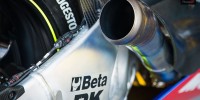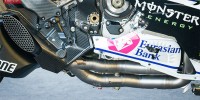Honda RC213V Exhaust Design
![]()
 The design of this final section is one area where I have noticed changes over the past few years. Changing the back pressure is one thing the engineers can do to affect engine performance even in this age of sealed engines and frozen development.
The design of this final section is one area where I have noticed changes over the past few years. Changing the back pressure is one thing the engineers can do to affect engine performance even in this age of sealed engines and frozen development.
![]()
 I have noticed changes in the where the two sections of pipe join into a single pipe. Sometimes the join has been closer to the rear cylinders, thus reducing the distance the exhaust gases travel before being forced into a single pipe, and sometimes the join has been farther. The size of the megaphone section at the end also appears to vary, at least to the naked eye. This of course is very difficult to verify, even with the ability to photograph the bikes in pit lane. I hardly ever shoot the bikes from exactly the same perspective and distance, which is what I’d need to do to be able to prove that one day’s megaphone section is larger than another’s.
I have noticed changes in the where the two sections of pipe join into a single pipe. Sometimes the join has been closer to the rear cylinders, thus reducing the distance the exhaust gases travel before being forced into a single pipe, and sometimes the join has been farther. The size of the megaphone section at the end also appears to vary, at least to the naked eye. This of course is very difficult to verify, even with the ability to photograph the bikes in pit lane. I hardly ever shoot the bikes from exactly the same perspective and distance, which is what I’d need to do to be able to prove that one day’s megaphone section is larger than another’s.
![]()
 But some changes are so obvious that they make plain the degree to which the engineers play around with how the exhaust design affects engine performance. This is the rear section from Bradl’s RC213V at Silverstone last season. Notice that the 2 into 1 join is much closer to the bodywork, and the shape of the pipe’s bend is dramatically different. It’s a longer loop, thus lengthening the single pipe section both by joining the two pipes earlier and by lengthening the final section.
But some changes are so obvious that they make plain the degree to which the engineers play around with how the exhaust design affects engine performance. This is the rear section from Bradl’s RC213V at Silverstone last season. Notice that the 2 into 1 join is much closer to the bodywork, and the shape of the pipe’s bend is dramatically different. It’s a longer loop, thus lengthening the single pipe section both by joining the two pipes earlier and by lengthening the final section.
Coming up: The Aprilia RS-GP exhaust design makes both the Yamaha and Honda designs look like models of simplicity.
Photographs: ©2014-15 by Scott Jones / PHOTO.GP – All Rights Reserved
[mgallery keyword=”Pit Lane”]










Please sign in or register to contribute a comment or question.